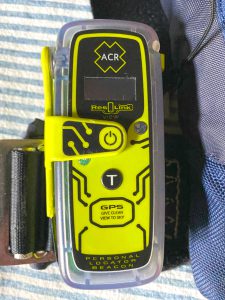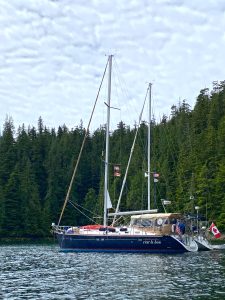When a PLB is accidentally activated in a remote area, the Canadian Coast Guard responds.
This past summer, my wife, Terri, and I set out to circumnavigate Vancouver Island on our 2006 Beneteau 423, c’est le bon. Starting from our winter storage location in Anacortes, Washington, we rendezvoused with our boat buddies in Sidney, British Columbia, and proceeded clockwise around Vancouver Island.
Once we progressed north of Tofino on the island’s west coast, communications with the outside world were primarily restricted to VHF radio and there was virtually no cell phone coverage. With its rugged beauty, many islands, and sweeping views, this wild and largely deserted stretch of coast is definitely worth visiting. However, the limited options for communicating with the outside world, not to mention the relative lack of fellow boaters and rescue services, encouraged us to consider additional backups. We carried a Spot X on our boat, which has an SOS feature that allows communications via satellite using short text messages. c’est le bon also has a dedicated emergency position indicating radio beacon (EPIRB) and I have a personal locator beacon (PLB) attached to my personal floatation device that I wear when I’m outside the cockpit.
We sailed farther up the coast in early July, exploring as many of the island’s inlets, sounds, and anchorages as possible. After rounding Cape Cook on the notorious Brooks Peninsula on Aug. 11, 2022, we made our way to a lovely anchorage in Klaskino Inlet, inside Scouler Pass. We anchored c’est le bon about 300 meters from shore, and later that evening we rowed our dinghy to the beach to join our friends and the crew of another boat for a campfire below the high-water mark. Arriving at the beach, I removed my life jacket and the clip-attached PLB, and laid it in the bow of the dinghy as I normally do. Nothing out of the ordinary. After a fun time with friends, a little shy of two hours later, we left the beach to row back to the boat.

With no cell coverage and limited VHF range, Klaskino Inlet is a remote place on Vancouver Island’s northwest coast.
As I reached to don my life jacket for the dinghy trip, I became aware that the PLB light was flashing. Realizing this meant that the PLB had been activated, I immediately attempted to deactivate it. Unfortunately, in the diminishing daylight, I was unable to find the power button, which is hidden beneath a protective cap attached to the antenna. Both the protective cap and antenna were still in place in their storage positions, which are designed to minimize the probability of accidentally arming the PLB and sending out a distress signal. After the short row back, we were on the boat and I was able to pull the antenna and protective cap off and deactivate the PLB by simply pushing the power button.
About three or four minutes after deactivating the PLB, while I was debating whether to call the Prince Rupert Coast Guard station on the VHF to report the accidental activation, I heard the sound of a high-power engine moving rapidly somewhere out in Klaskino Inlet — a highly unusual sound at that time of night. The sound turned out to be a Canadian Coast Guard search and rescue Cormorant helicopter, flying low and fast. When it cleared the nearest headland I could make out its navigation lights, and it immediately turned directly toward us and hit me with the spotlight.
I knew instantly why they were there.

c’est le bon’s PLB is an ACR Electronics model 425.
Quickly switching on c’est le bon’s main VHF radio, I established communications with both the rescue helicopter and Prince Rupert Coast Guard radio to confirm that there was no distress and that the PLB had been activated accidentally somehow. The Coast Guard advised that it was canceling the emergency (“mayday fine”) and standing down the helicopter, which had been sent from Comox, on the eastern side of the island. Also standing down was a Canadian warship that had also been mobilized from Quatsino Inlet, some 30 miles away by sea. The Coast Guard further advised that there would be no charge for the callout. This was good to hear.
While we were at the beach, c’est le bon’s VHF radio was not turned on, since there was no one on the vessel. We didn’t carry a handheld VHF with us to the beach, as everyone within range that we might wish to talk to was going to be on the beach with us anyway. The Spot X tracking device that we carry was also left on the boat and had been turned off for the night. Where we were anchored in Klaskino Inlet, as indeed virtually everywhere on the west coast of Vancouver Island, there is no cellular service.
The following morning, when I turned on the Spot X, I found three messages waiting from the Canadian Coast Guard. A couple of days later, when we finally got a cell phone signal, there were three more Coast Guard messages in my voicemail and text message inboxes. There was also one from my son in Houston, Texas, who was awakened at midnight by an urgent call from the Coast Guard, asking if he had heard from me.
Since I had not seen a flashing light on the PLB the entire time we were on the beach, I assumed it had been activated as we were boarding the dinghy to return to the boat, and that it had therefore only been operating for a few minutes. However, further discussions with the Coast Guard, as well as the various messages on my Spot X and cell phone, confirmed that the PLB had been activated when we arrived at the beach. Accordingly, it had been sending a distress signal out for nearly two hours by the time I discovered it was active. After the Coast Guard had exhausted all attempts to make contact with me, including contacting my son to confirm that we were indeed boating in the vicinity, they mobilized a full rescue operation at about 10 p.m. local time.
I take this event very seriously and absolutely want no part of false alarms. My wife and I talked through the steps leading up to the PLB activation and have not been able to come up with any reason to explain it. Despite our best efforts, we have been utterly unable to determine how the PLB was activated, even after multiple attempts to recreate the event. The Coast Guard duty officer advised that these types of PLBs can be activated by a sharp blow, and told me they had once found an activated PLB in the overhead storage bin of a commercial airplane that had landed a bit hard.
At the end of the summer cruising season, I discussed the event with a technician at Marine Safety Services in Seattle, Washington, and he recommended that I replace the battery in the PLB, as it had used up some significant portion of its 24-hour life during this activation. This set me back about $200.
My PLB is an ACR Electronics model PLB-425, P/N: 2922, with an (original) battery expiration date of 02/2027. I purchased it from West Marine in April 2021, just before crewing a yacht delivery from Bermuda to the Azores. The Marine Safety Services technician confirmed that the unit was in excellent condition and operating well — which we obviously found out.
I wish to express my sincere thanks to the Canadian Coast Guard, and specifically the crews of the Cormorant SAR aircraft and Canadian warship (number unknown) for their respective mobilizations. I was able to contact the duty officer at Comox, from where the helicopter was sent, to personally express my gratitude. Next time I’m in Comox, I owe you guys a beer.
The Takeaway

c’est le bon and buddy boat Massilia anchored and rafted together on their voyage around Vancouver Island.
What did we learn from this unfortunate event? For starters, the good news is that the emergency alert system absolutely works. The PLB’s emergency signal was picked up immediately by satellite with very accurate latitude and longitude information included, and the Canadian Coast Guard was informed. The Coast Guard very quickly tried multiple means of contacting me — VHF and cell phone — and even reached out to people at Spot to contact me via my Spot X device. After communicating with my emergency contact and confirming that we were boating in the area, the Coast Guard mobilized multiple resources to the scene within a reasonably short period of time. Count me as impressed.
A PLB located on your personal floatation device is a worthwhile safety device and should be worn by any serious boater. If you become separated from the mother boat and are unable to return to it, the PLB provides a means of contacting rescue services. I am confident that I did not abuse my PLB, but there is no doubt that it was activated somehow. I now treat it with a bit more care when donning and removing it, and any time I take a knock or stumble while wearing my life jacket, I check it immediately to make sure the light is NOT flashing.
I recommend that you follow my advice to avoid a similarly embarrassing callout for emergency services. It would also be a good idea to carry a handheld VHF radio any time you leave your boat, especially in areas where there is no cell service. Although a VHF radio may not have the transmission power to talk to the Coast Guard, it may be possible to hear alerts that the Coast Guard broadcasts.





